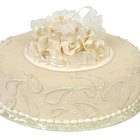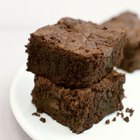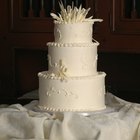
Under ordinary circumstances, the frosting on a soft, delicate cake should also have a soft and delicate texture. But sometimes it's handy to make an icing that hardens a little bit. It's a characteristic that cake decorators call "crusting," and they value it for specific uses. You can make a separate frosting for these purposes, or tweak your regular frosting to encourage crusting.
Why It's Useful
Frosting that crusts might be useful in decorating your cake for several reasons. Most decorators apply a thin coat of frosting as a "crumb coat" over the cake, to keep crumbs out of the final coat and provide a base layer. This works better if you use a crusting type of frosting. A frosting that crusts to a firm surface, however thin, is also better as the base for a highly ornamented cake. The decorator has greater latitude to create decorative effects, knowing the base coat of frosting won't smear. Frosting decorations hold their shape better if they're made with a crusting-type frosting, and they're also more stable in hot or humid weather.
Basic Decorator's Frosting
One of the simplest forms of frosting, often called basic buttercream or decorator's buttercream, can easily be made in a crusting version. It's made by creaming powdered sugar together with fat and flavorings, until you achieve the right consistency. Butter gives the best flavor, but for a crusting version it's better to use shortening and extra sugar. Cream them together until very smooth, then add the vanilla and enough milk to bring the mixture to a smooth, dense, creamy texture. Use the frosting right away, or seal it from the air by pressing plastic wrap directly to its surface. Otherwise it will crust in the bowl, and form lumps.
Tweaking Your Buttercream
If you have a large quantity of commercial or homemade buttercream and don't want to make a separate frosting for your decorations, meringue powder can be the answer to your problem. It's a mixture of dried egg whites, sugar, vanilla and various emulsifiers and stabilizers. If you beat 1 or 2 tablespoons of meringue powder into your regular buttercream, it creates a mild crusting effect that gives your decorations sharper, cleaner edges and better durability in hot or humid weather.
Royal Icing
Some designs and decorations require a frosting that doesn't just crust, but instead sets to a perfectly hard texture. That's the role of royal icing, which makes the elegant filigree and swag patterns on wedding cakes as well as the hard, crunchy floral decorations. Royal icing is made by whipping egg whites or reconstituted meringue powder with large quantities of powdered sugar. Once made, it hardens quickly, so it must be covered at all times when it's not in use.
Related Articles

Can I Crumb Coat a Cake With Whipping ...

How to Add Meringue Powder to ...
How to Make Bakery-Style Whipped Icing

The Difference Between Butter Cream and ...

How Long Does it Take for Marzipan to ...

The Difference Between Whipped Icing & ...

Can You Use Heavy Cream When Making ...

How to Make Whipped Frosting Without ...

Adding Cream of Tartar to Macaroons

Do You Need to Refrigerate Whipped ...

How to Keep Your Buttercream Icing With ...

How to Make Cake Frosting Into a ...

What Is Dirty Icing in Cake Decorating?

Can Softened Frosting Harden Over a ...

Can I Make Brownies With Confectioner's ...
Best Homemade Cream Cheese Frosting

Ganache Substitute

How to Decorate Fake Cakes

How Long Can Cupcakes Be Stored After ...
What Do Bakeries Use in Their Whipped ...
References
- The Professional Pastry Chef; Bo Friberg
- King Arthur Flour: Quick Buttercream Frosting
Writer Bio
Fred Decker is a trained chef and prolific freelance writer. In previous careers, he sold insurance and mutual funds, and was a longtime retailer. He was educated at Memorial University of Newfoundland and the Northern Alberta Institute of Technology. His articles have appeared on numerous home and garden sites including GoneOutdoors, TheNest and eHow.
Photo Credits
Creatas Images/Creatas/Getty Images